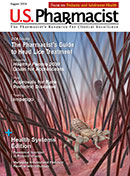In a publication in Innovations in Pharmacy, researchers conducted a study to evaluate the percentage difference in the international normalized ratio (INR) target range of patients on anticoagulation when managed by a community-based pharmacist with a collaborative practice agreement (CPA) versus a physician. The researchers also sought to examine patient satisfaction when managing warfarin by a community-based pharmacist with a CPA versus a physician.
The authors wrote, “Warfarin has many indications; however, it is the only anticoagulant that is indicated for mechanical mitral valve and antiphospholipid syndrome. Management may be conducted by pharmacists in medical clinic settings.”
Using a quasiexperimental design, researchers conducted a retrospective chart review of patients enrolled in the anticoagulation clinic from January 1, 2020, to June 30, 2022.
This study included patients aged 18 years or older with an indication for warfarin and attendance at least three anticoagulation appointments. The time in therapeutic range (TTR) was established employing the traditional method.
The authors wrote, “TTR differences across the two groups were reported using descriptive, bi-variate, and multivariate statistics. All statistical tests were conducted using SAS 9.0. Patient satisfaction was collected for 6 months using a survey created by the investigators. Survey consisted of 18 questions using a 3-point Likert scale. Survey was assessed using descriptive statistics.”
The results revealed that among the 37 patients who met the inclusion criteria, 26 patients who pharmacists managed had 609 appointments, while 11 patients under physician management had 123 appointments. Moreover, the results revealed that the time spent in the therapeutic range was comparable between the pharmacist-managed group (60.7%) and the physician-managed group (59.4%), with no statistically significant variance (P <.829), and the results from the satisfaction survey revealed a slight partiality for pharmacist-led management over physician-led care.
Based on their findings, the authors concluded that community-based pharmacist warfarin management of TTR was comparable with management by physicians and the degree of patient satisfaction was relatively comparable.
The results from the survey revealed that neither group was unsatisfied with the pharmacist or physician monitoring their INR; however, the patients in the pharmacist group were consistently satisfied with the service provided by the pharmacist, and patients in the physician group answered “neither satisfied nor unsatisfied” more frequently than those in the pharmacist group.
The authors wrote, “As community-based pharmacists expand patient care services, evidence of equivalent care has both policy and payment implications. A community-based pharmacist anticoagulation service is a viable option to increase access to care for anticoagulation patients.”
The authors also noted, “In the future, a prospective study should be conducted to assess the difference in the time in the therapeutic range between physician-managed and community-based pharmacist-managed anticoagulation clinics to increase the generalizability of the data. The study should employ a longer time frame to capture more patients or data points. A study with more patients and more complete demographic data will allow for sub-analysis opportunities and comparison of patient characteristics.”
The content contained in this article is for informational purposes only. The content is not intended to be a substitute for professional advice. Reliance on any information provided in this article is solely at your own risk.
Published July 18, 2024






